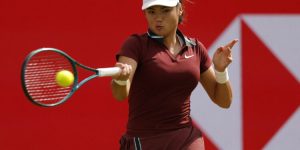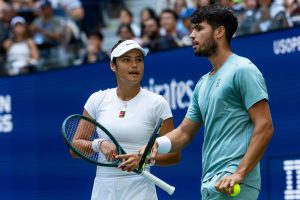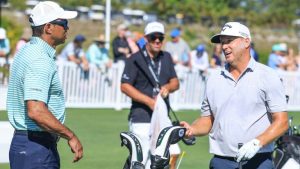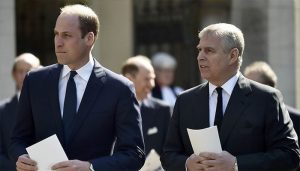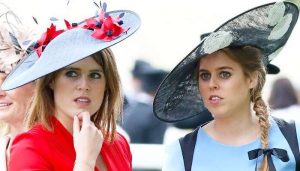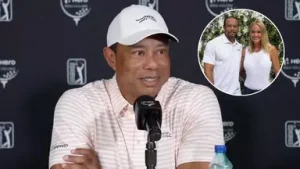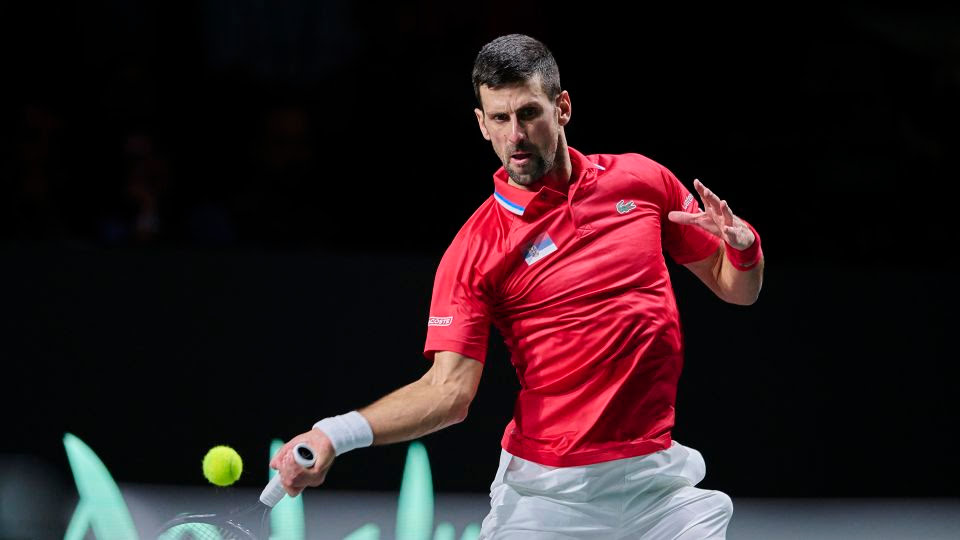
In 2023, Djokovic overcame injury, illness, and controversy to cement his GOAT status as he surged past the declining Nadal (22) and the retired Federer (20) to finish the year at 24 Grand Slam singles titles, a men’s record.
When tennis historians tell posterity about the legendary Big Three, Novak Djokovic won’t receive accolades as the most beloved champion or most electrifying shot-maker. Roger Federer will. Djokovic won’t rate as the most ferocious competitor or the most awesome performer on a particular surface. Rafael Nadal will.
But whether you like Djokovic or loathe him, agree with him or not about the controversies he’s created or confronted, not since Bill Tilden a century earlier has men’s tennis witnessed such a game-changing superstar. On the court, his virtually perfect technique combined with his holistic (albeit often unconventional) training methods have accounted for his extraordinary, age-defying success at 36. Indeed, Men’s Health magazine pondered whether Djokovic may be the fittest athlete of all time in any sport.
Off the court, he’s proven to be just as dedicated and astute by advancing the sport through the Professional Tennis Players Association, which he and Vasil Pospisil founded in 2019. The PTPA now represents 500 members. Djokovic has weighed in on every major issue, most notably poorly scheduled matches ending in the middle of the night, the badly mismanaged WTA Finals, the absurdly long 11-month tennis season, women’s rights, and the plight of financially strapped, lower-ranking players. In the last case, on Aug 24, the ATP approved a minimum wage plan.
In 2023, the strong-willed Serb overcame injury, illness, and controversy to cement his GOAT status. By winning three Grand Slam singles titles for a men’s record of 24, Djokovic surged past the declining Nadal (22) and the retired Federer (20). It marked the third year in his incomparable career he came within one match of the Holy Grail of tennis — a Calendar Slam. This time, Djokovic fell tantalisingly short at Wimbledon. Carlos Alcaraz, a down-to-earth Spaniard who plays out-of-this-world tennis, thwarted him in a riveting, five-set final.
Djokovic’s record-smashing journey started at the Australian Open. A painful left hamstring injury nearly prevented Djokovic from even playing in the tournament he’d won a record nine times. Goran Ivanisevic, his coach, said an MRI scan showed it was so serious that “97 percent of players” would have withdrawn, but “He is from outer space.” With Alcaraz, the US Open champion and No. 1, absent due to a right leg injury, Djokovic became a heavy 4-7 betting favourite. A good draw helped, as did the defeats of talented young contenders third-seeded Casper Ruud, sixth-seeded Felix Auger-Aliassime, eighth-seeded Taylor Fritz, and ninth-seeded Holger Rune, while defending champion Nadal, hampered by a serious hip injury, was upset by 56th-ranked MacKenzie MacDonald.
The remaining contenders gave Djokovic little competition. In the quarterfinals, he thrashed Andrey Rublev, a one-dimensional slugger, 6-1, 6-2, 6-4, and drubbed athletic American Tommy Paul, a 100-1 longshot in his first major semifinal, 7-5, 6-1, 6-2.
Neither a large contingent of boisterous Greek-American spectators nor a nasty heckler deterred Djokovic in the final when he broke down Stefanos Tsitsipas’ vulnerable one-handed backhand for a 6-3, 7-6, 7-6 triumph for his record-extending 10th Australian and record-tying 22nd major title.
The Serb proudly pointed towards his head, his heart, and his testicles to emphasize those tennis attributes. Then, soaking in the applause, he raised his arms, motioning to get even more. Spectators continued to chant “Nole! Nole!” as he walked toward his player’s box.
There, in one of the most memorable victory celebrations of a Grand Slam title in history, tears of ecstasy, relief, and gratitude flowed from Djokovic. Climbing into his player’s box, Djokovic repeatedly hugged his family and team … and then in an iconic moment that eclipsed even his most spectacular shots, he fell into their comforting arms and lay there weeping.
“He’s the greatest that’s ever held a tennis racket,” praised Tsitsipas.
If there were any doubt about that, Djokovic would dispel it at the next Grand Slam tournament.
Alcaraz, the youngest and first teenage world No. 1 and year-end No. 1 in ATP Rankings history (since 1973), burnished his clay-court credentials by taking tournaments at Barcelona and Madrid. With 14-time Roland Garros champion Nadal sidelined, Alcaraz and Djokovic were the co-favourites in Paris.
With his precocious mixture of ferocious power and finesse, exceptional speed, and Nadal-like competitiveness, Alcaraz crushed all five opponents going into the semifinals, most notably No. 5 Tsitsipas, No. 17 Lorenzo Musetti, and No. 26 Denis Shapovalov. Djokovic reached the penultimate round after being tested only by No. 11 seed Karen Khachanov, who succumbed 4-6, 7-6 (1), 6-2, 6-4.
With a 16-year age gap, the largest since Jim Courier whipped Jimmy Connors at the 1991 US Open, the highly touted “Battle of the Ages” sizzled for two sets the superstars split. At that point, Courier, now a Tennis Channel analyst, said, “It’s living up to its incredible hype.”
Then, after two hours and 11 minutes of hard-hitting and fast-running tennis, cramps wracked the Spanish phenom. What happened? The consistently penetrating shots of Djokovic, along with the 87-degree heat, and especially the mental pressure of facing the sport’s new GOAT, did in the flashy but sometimes erratic Alcaraz. Hobbled for the rest of the match, Alcaraz meekly went down 6-3, 5-7, 6-1, 6-1.
In the anti-climactic 7-6, 6-3, 7-5 final, Djokovic often made the world No. 4 Ruud, a gentlemanly Norwegian, appear like a mere foil to display the Serb’s greatness. In an NBC interview afterward, Ruud said, “Novak is not human at times. It’s scary how good he can play.”
Besides surpassing Nadal with his 23rd major title, Djokovic was halfway to a rare calendar-year Grand Slam. Closing in on his eighth Wimbledon crown, the intense Serb oozed confidence. “I know my opponents want to get a scalp, they want to get a win. But it ain’t happening, still,” crowed Djokovic after his 6-1, 6-4, 6-3 quarterfinal win over No. 7 Rublev.
After outclassing Daniil Medvedev 6-3, 6-3, 6-3 in the Wimbledon semifinals to set up the eagerly anticipated “dream final,” Alcaraz welcomed the challenge. “My dream is to be here and even better to play Novak.” Prior to the match, Alcaraz also oozed confidence. “I will believe in myself; I will believe that I can beat him here.”
Djokovic reached his record 35th major final by defeating another rising star, 21-year-old Jannik Sinner. Experience and versatility trumped youth and brute power, 6-3, 6-4, 7-6 (4). Playing the big points as only he can, Djokovic saved all six break points and extended his tiebreaker winning streak at majors to 15, a record. “36 is the new 26,” said the exhilarated Serbian.
The odds-makers had Djokovic as a solid 1-2 favourite, but IBM Watson favoured Alcaraz 55 percent to 45 percent. John McEnroe, the ESPN analyst who captured three Wimbledon titles in the 1980s, said, “If he brings his ‘A’ game, he can beat Djokovic.”
With an estimated 1.2 billion sports fans around the world watching this enthralling Battle of the Generations, Alcaraz showcased his A-plus game when it mattered most—in the pivotal second set tiebreaker and the deciding set.
Djokovic reached set point, at 6-5 in the tiebreaker, with a backhand passing shot, ending a 17-shot exchange. Shockingly, the far more experienced Serb let his opponent off the hook with two unforced errors on the backhand, normally a rock-solid shot. Alcaraz then grabbed the critical tiebreaker with a backhand serve return down the line that caught Djokovic flat-footed.
With Djokovic serving at 1-all in the deciding set, Alcaraz proved much stronger physically and mentally than in their Roland Garros encounter. Seizing the moment, he belted a backhand winner for love-15 and wrong-footed Djokovic with a perfect forehand volley for 15-30. Alcaraz partisans chanted “Carlos! Carlos!” while Djokovic fans countered with “Novak! Novak!”
On break point, the Spaniard whacked a backhand passing shot down the line to take a 2-1 lead. Pleased with his smart shot selection and skilful execution, he pointed to his head. Djokovic, exasperated, smashed his racket on the wooden net post and received a code violation from chair umpire Fergus Murphy.
Serving for his second Grand Slam title at 5-4, Alcaraz showcased several of the weapons in his vast arsenal. A forehand lob winner made the score 15-all, an acrobatic backhand volley 30-15, and an unreturnable, 130-mph serve 40-30 and championship point. When Alcaraz boldly rushed net, Djokovic’s forehand passer landed in the net.
Game, set, match, and Wimbledon title, Alcaraz 1-6, 7-6, 6-1, 3-6, 6-4.
Carlos thus became the youngest Wimbledon men’s champion since 18-year-old Boris Becker in 1986. Like Becker, he epitomized fearless aggression and rugged athleticism, pounding 18 winners—versus just three for Djokovic—in the deciding set.
“It’s a dream come true for me,” Alcaraz said. “I fall in love with grass right now!”
Always gracious in defeat, Djokovic praised the sui generis Spaniard. “I think people have been talking in the past 12 months or so about his game consisting of certain elements from Roger, Rafa, and myself. I would agree with that,” Djokovic said. “I think he’s got the best of all three worlds. He’s got this Spanish bull mentality of competitiveness and fighting spirit and incredible defence. I haven’t played a player like him ever, to be honest. Roger and Rafa have their own strengths and weaknesses. Carlos is a very complete player. Amazing adapting capabilities that I think are a key for longevity and for a successful career on all surfaces.”
Two months later, Djokovic’s own dream of equalling Margaret Court’s all-time record of 24 Grand Slam titles would be realized in New York.
Despite being the most successful hard-court competitor in tennis history, Djokovic had won “only” three US Opens with the last coming in 2018. Both bad luck and his self-destructive ways accounted for the title drought. In 2019, an injury forced him to retire. The following year, Djokovic inadvertently hit a lineswoman with a ball in a fit of anger and was defaulted. In 2021, drained mentally and physically from his long, stressful campaign to complete a rare calendar Grand Slam, he was decisively beaten by Medvedev in the final. Last year, recalcitrant Djokovic, being No-Vax, was banned from entering the U.S.
Questions abounded at the season’s final major. Had age finally caught up with the tennis GOAT at Wimbledon? Or did super athleticism and high energy simply trump efficiency and experience? What about the increasingly versatile Sinner, who had won three of six encounters with Alcaraz, showing his surface adaptability by doing it on hard, grass, and clay courts? Could another New Gen standout, the ruggedly built and combative Holger Rune, steal their thunder? The 20-year-old Dane had tamed his teenage temper and unleashed his vast talent to notch wins over Djokovic (twice), Alcaraz, Ruud, Sinner, Tsitsipas, Medvedev, Rublev, and Zverev.
Neither Sinner, outlasted by Zverev in five sets in the quarters, nor Rune, upset by unseeded Spanish veteran Roberto Carballes Baena in the first round, made the semifinals. Instead, Ben Shelton joined the new Big Three following impressive four-set victories over fellow Americans, 14th-seeded Paul and 10th-seeded Frances Tiafoe, also a surprise semifinalist a year earlier.
Boomer Shelton blasted consecutive 149-mph serves, the fastest during the tournament, against Tommy Paul, but, not surprisingly, his serve made little impact against the greatest returner in tennis history. The exuberant American wound up with just five aces and won only 60 percent of his first serve points as Djokovic romped to a 6-3, 6-2, 7-6 (4) victory.
Medvedev predicted he’d have to play “11 out of 10” to dethrone world No. 1 Carlos Alcaraz to reach his third US Open final. While Alcaraz provided a highlight reel of spectacular shots, particularly at net where he won 54 of 70 points (77 percent), Medvedev was a human backboard returning many of the Spaniard’s most offensive shots and eventually eliciting errors. Alcaraz committed five such errors in the critical first-set tiebreaker, which Medvedev clinched 7-3 with a forehand down-the-line winner. After fashioning the best technical and tactical match of his career—a spectacular 7-6 (3), 6-1, 3-6, 6-3 victory over Alcaraz—the loquacious Russian exulted, “I played 12 out of 10.”
On what it would take to conquer Djokovic, the undisputed tennis GOAT, the overly reverential Medvedev quipped, “I need to play 15 out of 10.”
Although Djokovic had long been the least tactical of the legendary Big Three, his approach has changed this decade, probably because of Medvedev’s unique counter-punching style and extremely deep court positioning on serve returns.
Djokovic repeatedly exploited Medvedev’s positioning with wide serves that created huge openings for penetrating groundstrokes and volleys. The key was that Medvedev never knew when Djokovic would do either option or even drop shot. As ESPN analyst Darren Cahill, who formerly coached Andre Agassi, said, “Novak, tactically, is playing the perfect match. He’s never playing the same point twice in a row.”
Even the cleverest tactics require sound execution, and the Djoker’s volley and half-volley were never better. He won an astounding 20 of 22 serve-and-volley points and a remarkable 37 of 44 net points overall. With the geometric brilliance of Pythagoras, Djokovic angled his volleys to the remotest areas to foil the speedy, long-legged Medvedev.
Djokovic had a complicated relationship with New York fans over the years, but when he broke serve to lead 3-1 in the third set, they roared in appreciation. His guts and guile paid off. Meanwhile, Medvedev fought desperately to hang on and held serve to close the gap to 5-3. On championship point, the Russian, exhausted and suffering from a left shoulder injury, erred on a backhand and succumbed 6-3, 7-6, 6-3.
In his poignant victory speech, Djokovic said, “I fell in love with tennis” and “I’m living my childhood dream.” He also spoke about his long and brilliant career. “I never imagined that I would be here standing with you talking about 24 Slams. I never thought that would be the reality. But the last couple of years, I felt I have a chance, I have a shot for history, and why not grab it if it’s presented?”
The good-natured Medvedev quipped, “I want to ask Novak, what are you still doing here? When are you planning to slow down a little bit? I feel like I’ve not had a bad career and I’ve won 20 titles, but you’ve won 24 Grand Slams. Wow!”
Djokovic, relentlessly motivated to break more records and make more tennis history, had no intention of slowing down. Despite a stomach virus, he won his seventh Paris Masters, coming back from the brink of defeat in three matches, to extend his record of Masters 1000 titles to 40.
At the ATP Finals in Turin, Italy, Djokovic lost one match in the round-robin stage, 7-5, 6-7, 7-6 to home favourite Sinner. It was the most watched tennis match of all time on Italian television, with 6.7 million viewers. The lanky 6’3” Italian, who added an effective drop shot to his repertoire and switched to a step-up serve that increased its power and accuracy, also defeated Medvedev 6-3, 6-7, 6-1, his third straight win over the Russian.
But Djokovic delivered two masterclasses when it mattered most, demolishing Alcaraz 6-3, 6-2 in the semis and trouncing Sinner 6-3, 6-3 for a record seventh ATP Finals title.
Ever the perfectionist, Djokovic hit his forehand harder than ever in 2023, and, as Nick Kyrgios said, “His instincts at net have improved out of sight.” Djokovic also served with power and precision to the tune of 13 aces and no double faults against Sinner. An astounding 80 percent of Djokovic’s first serves landed within one foot of the service box lines, according to Amazon Prime.
“What’s he going to improve next year?” wondered Courier. “The young bucks are coming for him, but he has the solutions.”
Sinner got in the last word when he went unbeaten in three singles and two doubles matches to lead Italy to its first Davis Cup since 1976. In the semifinal, he defeated Serbia’s Djokovic in both singles—escaping three match points in his 6-2, 2-6, 7-5 victory—and doubles. Then he overpowered Alex de Minaur 6-3, 6-0 to clinch the final against Australia.
The Djoker earned the year-end No. 1 ranking for the eighth time to extend his own record of brilliance and longevity. This will prove hard to surpass, unless, of course, he does it himself.
Will Djokovic have “the solutions” in 2024? The sports world wants to know what this ageless wizard has left as he chases his 25th Grand Slam title, which would break Court’s hallowed 50-year-old record, and targets a gold medal at the Paris Olympics—the only prestigious prize to elude his magical racket.
